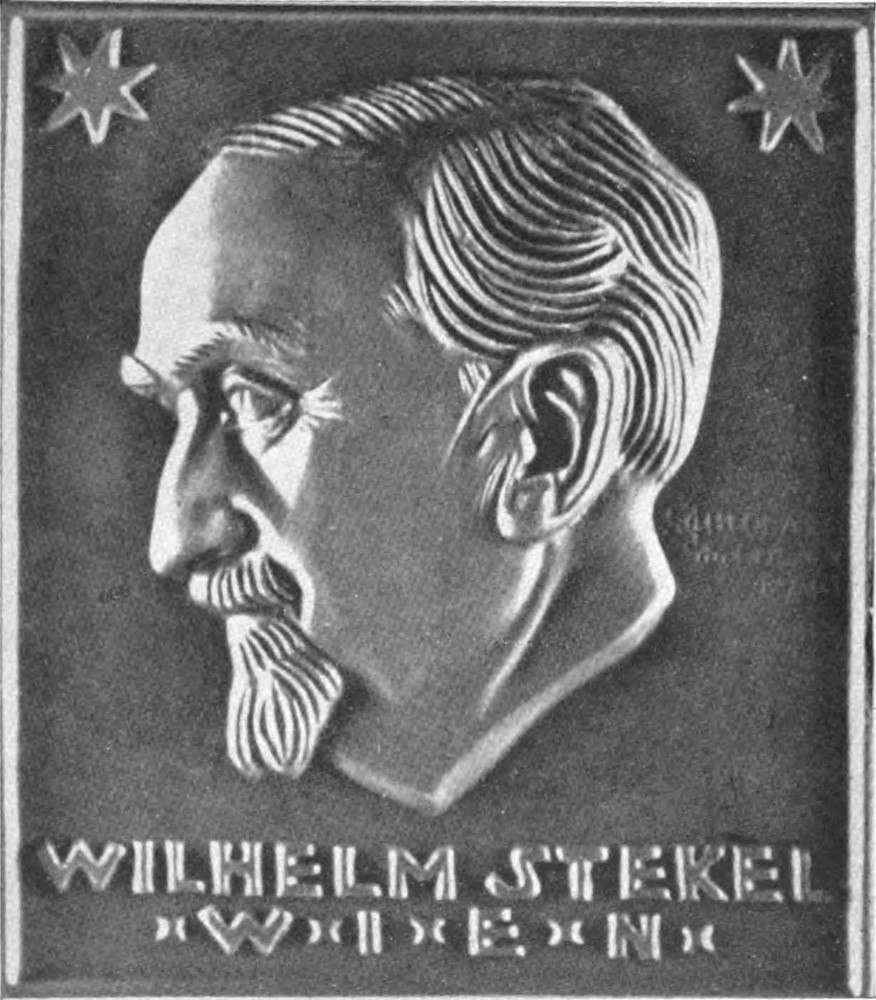
Plaque commemorating
Stekel's sixtieth anniversay.
Source: frontispiece, Stekel, Autobiography.
Wilhelm Stekel (1868-1940) trained in medicine at the University of Vienna in the 1890s, attending courses offered by Richard von Krafft-Ebing (1840-1902) and probably also by Freud, and focusing on the study of sexuality. In 1901 Freud referred Stekel to a colleague, Max Kahane, with whom Stekel then began a course of psychoanalytic treatment. In late 1902, Stekel suggested to Freud the idea of organizing regular meetings of a discussion group (Jones, 1953, who cites Freud on Stekel's priority). The result was the historic Psychological Wednesday Society, as Freud called it; it was also known as the Wednesday Psychological Society. Stekel wrote weekly reports of these meetings for publication in the Sunday edition of the Neues Wiener Tagblatt, a daily newspaper in Vienna.
By 1903 Stekel was accepting his own patients for psychoanalysis. His notorious reports on his "Wednesday patients," which always matched and corroborated cases presented by others, were accompanied by steady erosion of his clinical judgement and reliability. He is, however, credited with great psychological intuition and grasp of symbolism, to which Freud arrived late.
At the Salzburg First International Congress in 1908, Stekel presented a paper on "Anxiety in Hysteria." By 1910 he was, with Alfred Adler, a leading critic of the favouritism shown by Freud to C. G. Jung. Although Freud made Stekel and Adler editors, in 1910, of a new journal, Zentralblatt für Psychoanalyse, the gesture availed him little. By 1912 Stekel had resigned all of his positions; he later emigrated to London where he committed suicide in 1940 while suffering from a painful medical condition.
Stekel's prolific output is interesting and wide-ranging but requires critical scrutiny. Ernest Jones noted Stekel's "lack of scientific conscience," whilst Freud - perhaps more ruffled - came to see him as "morally insane." Havelock Ellis nevertheless continued to cite Stekel's works, particularly his two-volume Sexual Aberrations (1923), as vital sources for his own later studies.
Bibliography
Ellis, Henry Havelock.The Psychology of Sex. London: Heinemann, 1933.
Jones, Ernest. The Life and Work of Sigmund Freud. Vol. 1. London: Hogarth Press, 1953.
Stekel, W. The Autobiography of Wilhelm Stekel. Life Story of a Pioneer Psychoanalyst. Edited by Emil A. Gutheil. New York: Liveright, 1950.
______. Die Sprache des Traumes. (The Language of Dreams.) Wiesbaden: Bergmann Verlag, 1911.
______. Frigidity in Woman. 2 vols. Trans. James van Teslaar. New York: Liveright, 1943. Originally published in 1926.
______. Impotence in the Male. 2 vols. Trans. Oswald H. Boltz. New York: Boni & Liveright, 1939. Originally published in 1927.
______. Sadism and Masochism. Trans. Louise Brink. New York: Liveright, 1953. Originally published in 1929.
______. Sexual Aberrations. The Phenomena of Fetishism in Relation to Sex. 2 vols. Trans. S. Parker. London: Vision Press, 1953. Originally published in 1923.
Created 24 February 2021